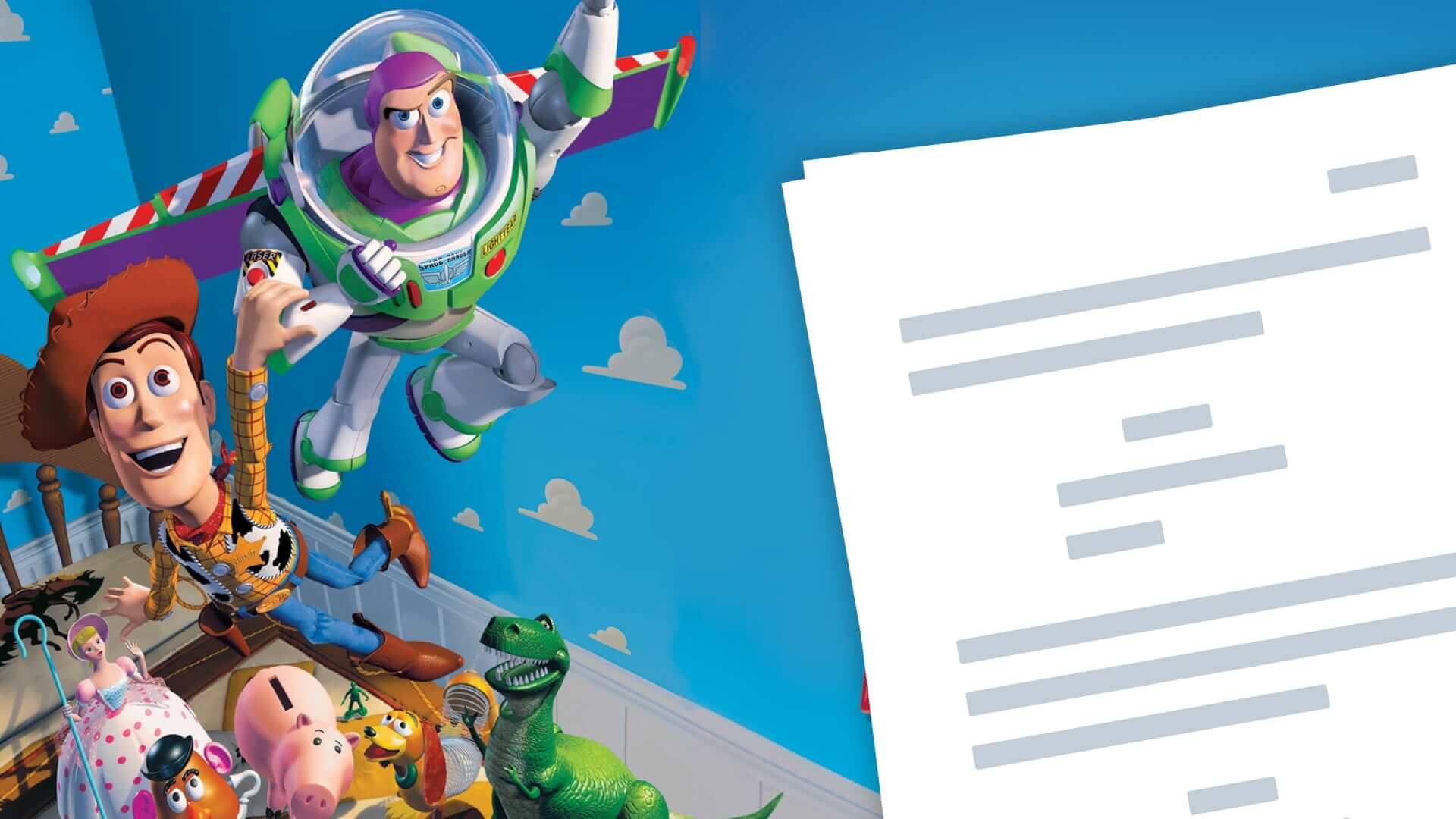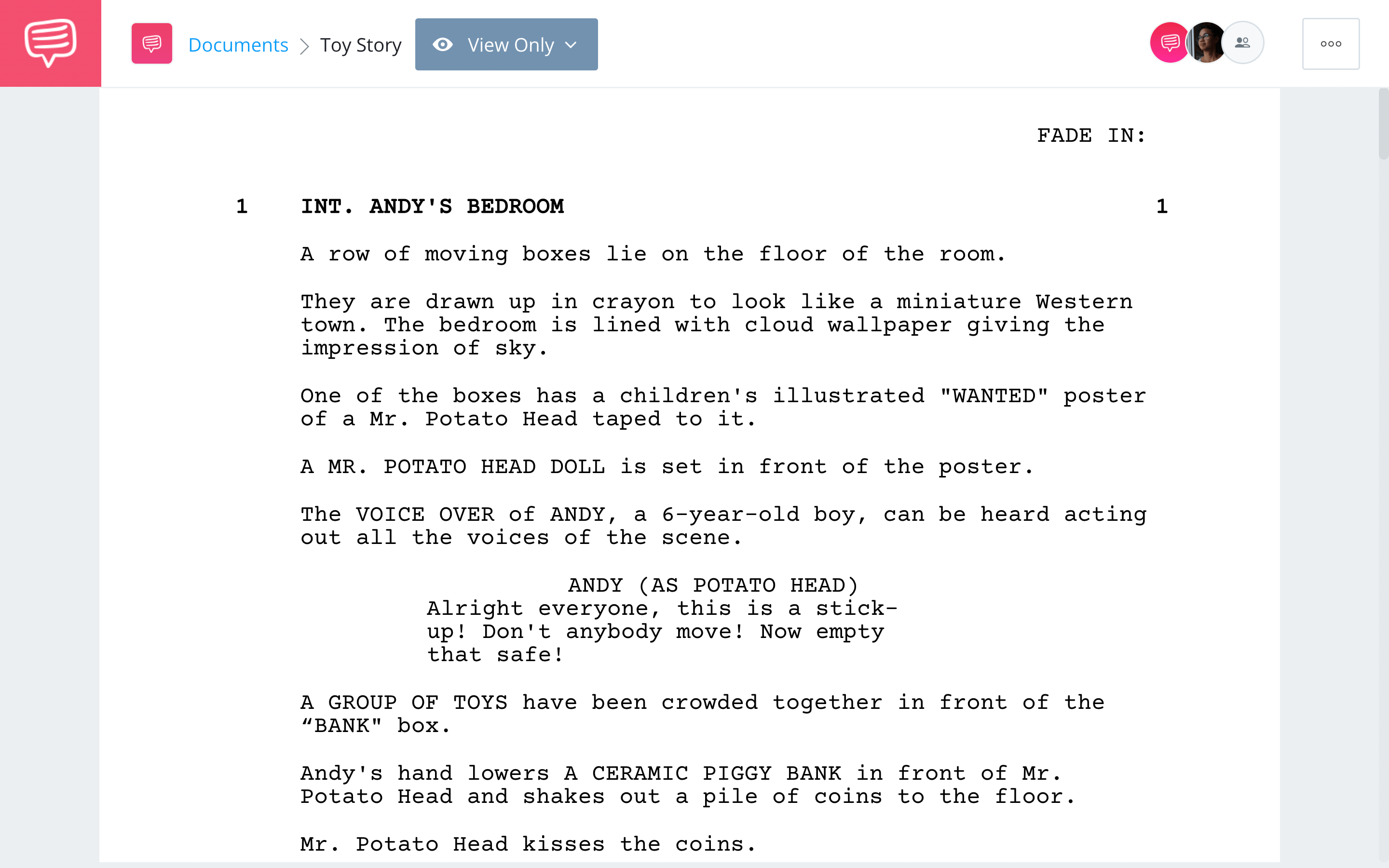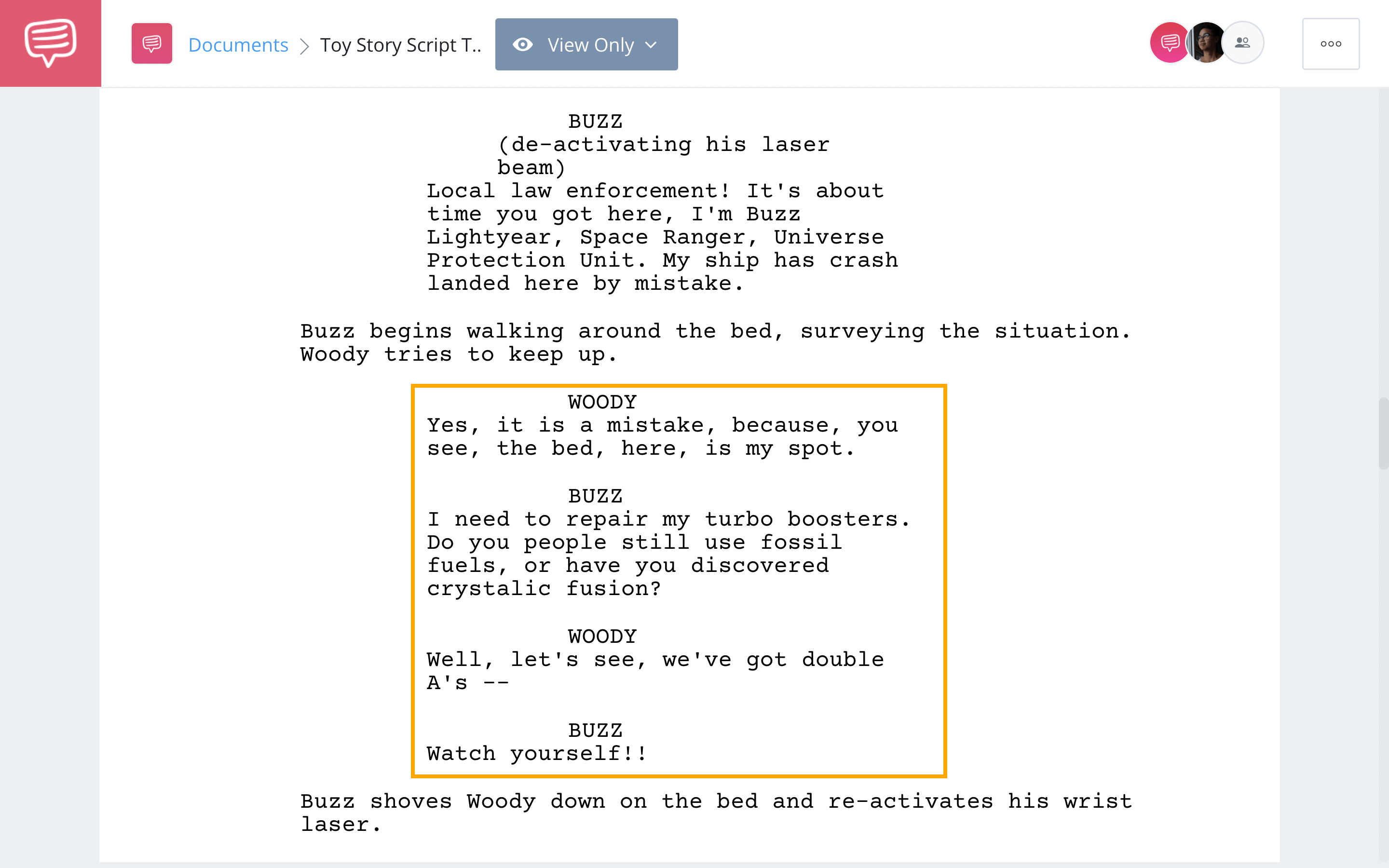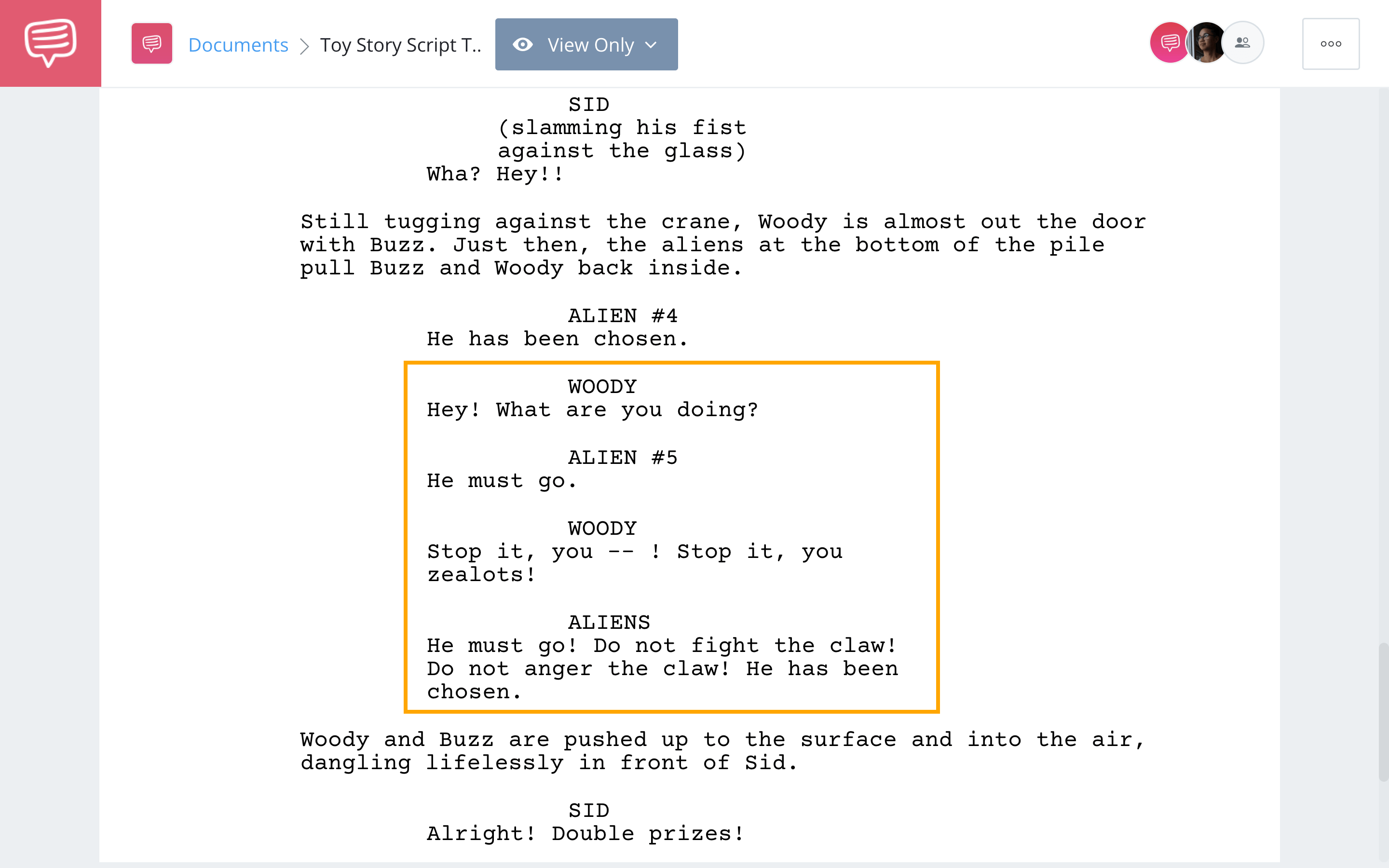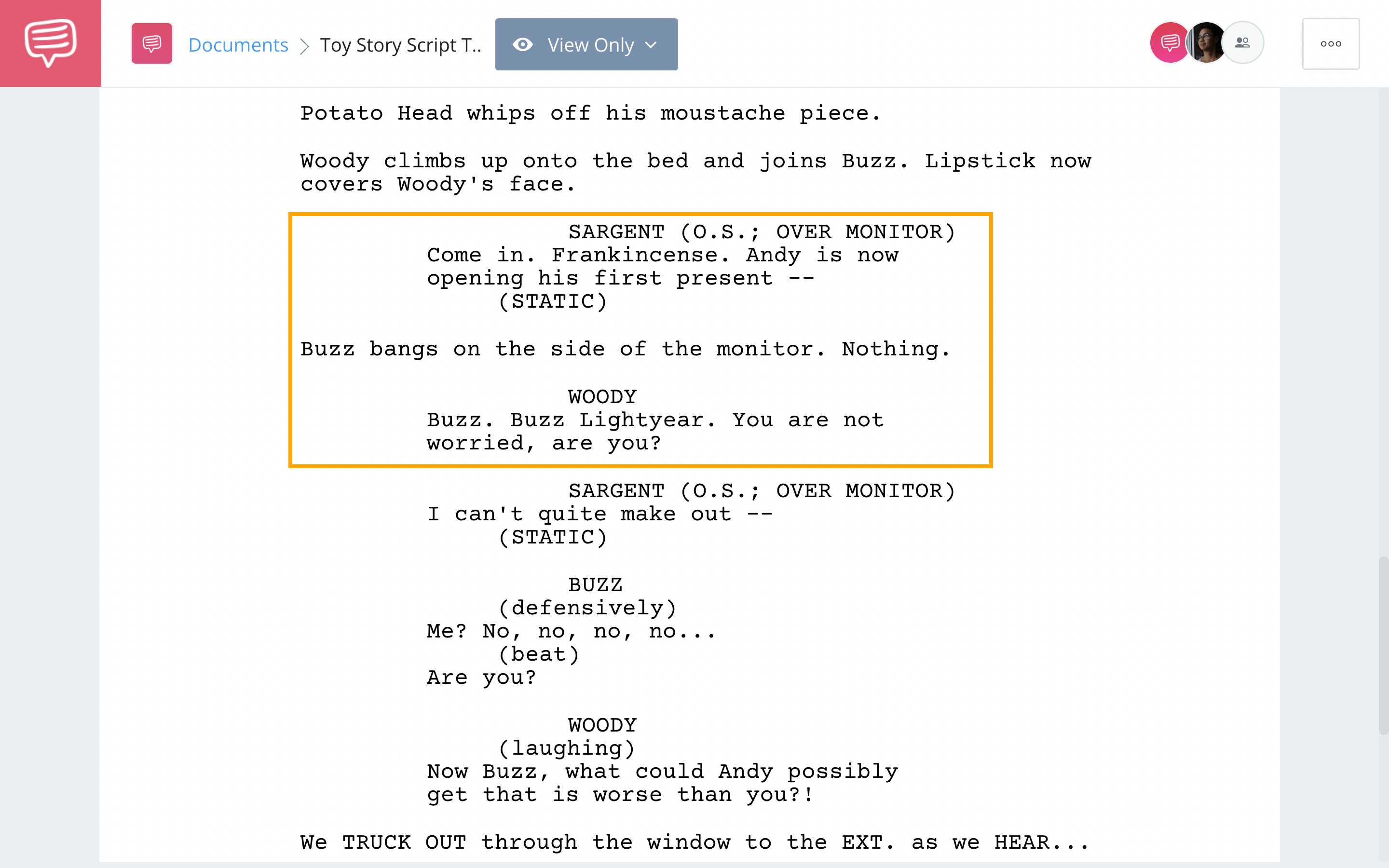Toy Story is recognized as one of the more revolutionary films that introduced CGI to the world of animation. However, in order for any of that brilliant animation to gain traction or make a difference, it had to be grounded in a brilliant story. Thanks to John Lasseter, Pete Docter, and the early team at Pixar, it was. In fact, the Toy Story script became the first animated film in cinema history to be nominated for a Best Original Screenplay Academy Award. So what makes the Toy Story script so brilliant? In this article, we’ll dive into how the Toy Story character arcs, obstacles, and ending created one of the most memorable and iconic animated films of all time.




WHO WROTE toy story SCRIPT?
Original story by John Lasseter, Pete Docter, Andrew Stanton, Joe Ranft
Screenplay by Joss Whedon, Andrew Stanton, Joel Cohen, and Alec Sokolow
Like most Pixar films, the creation of the Toy Story story and screenplay was a product of various imaginations. One of the more notable names on the writing roster is Pete Docter, famed writer and director of other Pixar films like Monsters Inc., Up and Inside Out.
However the main visionary behind Toy Story is John Lasseter who also directed the film. Lasseter began his career at Disney, but soon realized the true potential of CGI in the world of animation. Decisions led him to Lucasfilm (soon to be Pixar) and his work on the computer animated feature film began.
That film was Toy Story.
Lasseter went on to win an Oscar for Special Achievement for his work on Toy Story. The Toy Story screenplay would also be the first animated film in cinema history to be nominated for a Best Screenplay Academy Award.
TOY STORY PLOT BREAKDOWN
STRUCTURE OF Toy Story SCRIPT
Here is the story structure for Toy Story screenplay:
Exposition
A young boy named Andy has a collection of toys he plays with, his favorite of which is a cowboy named Woody. When Andy is gone, the toys come to life and have a meeting about Andy’s upcoming birthday.
Inciting Incident
Andy’s birthday party arrives and the toys are worried about Andy’s new toys. Andy runs in and moves Woody over for his new toy Buzz Lightyear. When Andy leaves, Buzz impresses all the other toys except for Woody.
Plot Point One
Out of jealousy, Woody sets a trap and Buzz falls out of the window. The other toys accuse Woody of killing Buzz. Andy can’t find Buzz and takes Woody to Pizza Planet. Buzz sees Andy and Woody leaving and grabs onto the minivan.
Rising Action
Woody and Buzz get left as they argue at a gas station. Woody convinces Buzz they must go to Pizza Planet for Buzz to return home. They sneak onto a Pizza Planet delivery car to get driven to where Andy is.
Midpoint
Sid, Andy’s evil neighbor, wins Buzz and Andy from a claw machine. Sid takes them home. They meet all of the Frankenstein-like toys Sid pieced together. Woody and Buzz must work together to escape from Sid’s house.
Plot Point Two
In the process of escaping, Buzz sees a TV commercial for the Buzz Lightyear toy and has an existential crisis as he realizes he’s just a toy. He attempts to fly to prove he is the real Buzz Lightyear, but tragically falls and loses his arm.
Build Up
Woody tries to rally Buzz to escape and almost does by stringing Christmas lights to Andy’s house. The other toys almost help reel them in, but see Buzz’s lost arm and think Woody murdered Buzz.
Climax
Sid straps a rocket to Buzz, Sid’s other toys attack him, allowing Buzz and Woody to escape. Woody and Buzz get to the house, but the moving van just left. Woody lights the rocket on Buzz’s back and the two get to the moving van.
Finale
During Christmas at Andy’s new house, Buzz and Woody wait to hear of any new Christmas toys for Andy. To their surprise, he gets a dog.
Toy Story Characters Analysis
Toy Story characters must grow
One of the most important elements of writing engaging characters is developing cohesive character arcs. A character arc is the change and evolution of a character’s personality over the course of a story.
Thoughtful character arcs are crucial for writing character development that emotionally connects with an audience.
Within Toy Story, the two main characters, Woody and Buzz, have different, yet complete positive character arcs.
Positive character arcs are commonly composed of three elements: a goal, a lie, and the truth. Let’s see what we can learn from Woody’s character arc.
For Woody, the goal is to maintain the role of Andy’s favorite toy. Once Buzz is introduced and takes this role, Woody’s goal is to retake the role of Andy’s favorite toy. The first thing Woody even says to Buzz attempts to reclaim his spot on the bed. Let’s take a look at this scene from the Toy Story screenplay in the StudioBinder screenwriting app.
Woody’s Goal • Toy Story screenplay
As you can see, Woody’s goal is immediate and concrete. For him there is no compromise. Woody’s goal of being Andy’s favorite toy is fueled by “The Lie” he tells himself which is that Woody needs to be Andy’s favorite toy in order to have value.
This lie is a deeply rooted misconception that further motivates Woody's goal.
For positive change and growth to take place within Woody’s character arc, Woody must overcome this lie by coming to “The Truth.” The truth being the fact that Woody does not have to be Andy’s favorite toy to still have value.
Woody arrives at this truth in the third act when he realizes that his time as Andy’s favorite toy has passed, but that does not take away from his value.
Toy Story characters • Woody and Buzz
Without coming to this conclusion and truth on his own, Woody may not have been able to snap Buzz out of his funk, and motivate him to push the crate for Woody’s freedom.
There are many things we can learn about the characters from the Toy Story screenplay. Woody’s character arc is a great example of the essential components of positive character growth.
Related Posts
Toy Story Script Conflict Analysis
Toy Story obstacles create themes
Establishing themes within a story has to be both subtle and effective. Toy Story shows us that being intentional with the obstacles created for a character can help reveal these themes in a subtle way.
Every plot point in Toy Story is based on a reaction. For example, Buzz is introduced as the new favorite toy. Therefore, Woody gets jealous and intentionally tries to get rid of Buzz.
Toy story Woody pushes Buzz out the window
Not only does this scene move the story along, but it reveals both character and themes. In this scene, Woody’s reaction to Buzz (the obstacle) creates the theme of jealousy.
The sequence when introducing an obstacle could simply be seen as follows: Establish a character's goal, challenge their goal with an obstacle, have the character’s reaction to the obstacle reveal themes while also setting up the next plot point.
Let’s take a look at another scene in which an obstacle is used to reveal another theme. When Buzz and Woody are taken by Sid from the claw machine, their plan of returning to Andy becomes much more complicated.
The Claw scene • Toy Story screenplay
Prior to this scene, Woody and Buzz clashed, but were close to getting back to Andy. Because Woody and Buzz are taken by Sid, they must overcome their differences and work together to escape. This contributes to the film’s themes of friendship and growth. It also facilitates growth in both Buzz’s and Woody’s character arcs.
As a screenwriter, it is important to be intentional when introducing an obstacle. Ask yourself: What type of conflict does this create? What theme does this serve? What will this reveal about a character? These obstacles should elicit a reaction from your characters that serves your story’s themes, tone, and character arcs.
Related Posts
Toy Story Script Breakdown
Toy Story ending comes full circle
One of the most satisfying parts of the Toy Story ending is how the story comes full circle with the last scene. The dust has finally settled and Woody and Buzz make it back to Andy. The last scene comes full circle as it draws direct similarities to the beginning scene of Andy’s birthday party. Only this time, Buzz is the one worried about the new toys.
Toy Story movie script ending scene
Not only is the ending of the Toy Story screenplay a great resolution to the conflict between Andy and Buzz, it also is a great way to encapsulate their character arcs.
Buzz has finally come to terms with the fact that he is not the real Buzz Lightyear. And Woody has come to terms with the fact that he doesn’t need to be Andy’s favorite toy to be loved. After all, now he has Bo Peep.
Toy Story ending
The great thing about the ending to Toy Story is that it closes the open loops by coming full circle. At the same time it also manages to leave the door open beautifully for the following sequels to come.
Related Posts
UP NEXT
Read and download more scripts
Pixar is not only a master of beautiful animation, they are a master of story. If you want to continue reading screenplays, we have similar titles like Up, Ratatouille, and Coco in our screenplay database. Browse and download PDFs for all of our scripts as you read, write and practice your craft to become the next great screenwriter.
